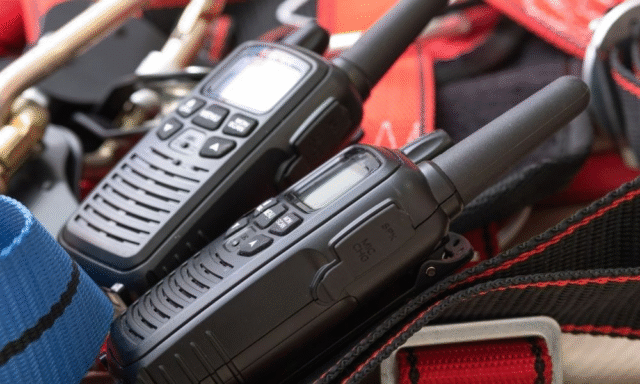Introduction: Why Reliable Radio Communication Saves Lives
Imagine a firefighter rushing into a burning building, trying to radio for backup, but unable to reach the command centre due to poor signal. That could delay help and cost lives. That is why an emergency responder radio communication system and a dedicated ERRCS system matter so much. These systems ensure first responders enjoy clear, reliable communication even inside large or complex structures. In the end, this clarity can make the difference between life and death.
What Is an Emergency Responder Radio Communication System?
An emergency responder radio communication system refers to any equipment or setup that enables emergency teams—such as police, fire, and medical staff—to maintain radio contact when inside buildings. Signals from radios often weaken in structures due to thick walls, steel, or underground levels. That is where this system comes in.
Main components include:
- Public safety radio systems outside the building
- In‑building repeater stations or antenna systems
- Coverage enhancement devices in key areas
- Regular maintenance checks and barrier management
Thus, first responders experience uninterrupted communication whether they’re in basements, upper floors, or enclosed corridors.
Understanding ERRCS System
ERRCS stands for Emergency Responder Radio Communication System. It’s a specific in‑building infrastructure designed to amplify public safety radio signals. Often, it’s built into walls or ceilings, distributing signal throughout every corner of a building.
Core elements of an ERRCS system:
- Donor antenna: Picks up the public safety signal from outside
- Bi‑directional amplifier (BDA): Boosts the signal strength
- Distributed antenna system (DAS): Sends the strengthened signal throughout the building
- Monitoring unit: Tracks performance and alerts staff if problems occur
Together, these elements make sure emergency teams always stay connected — even in complex indoor layouts.
Why Buildings Need These Systems
Both an emergency responder radio communication system and an ERRCS system ensure safety, but buildings and authorities often underestimate their importance.
Key reasons they are vital:
- Legal requirements: In many regions, codes demand adequate radio coverage for first responders
- Safety assurance: Responders need secure, real-time communication to coordinate rescues safely
- Faster response: Clear communication reduces delays and confusion
- Evacuation support: When systems fail, rescuers can still guide trapped individuals
Buildings such as hospitals, schools, shopping centres, or high-rises often rely on these systems for compliance and routine safety.
How These Systems Work Together
While an emergency responder radio communication system can be as simple as a handheld repeater, an ERRCS system offers a more formal structure. They complement each other to deliver continuous communication.
How they interact:
- ERRCS design begins after determining weak signal zones
- External roadside antennas feed into the internal BDA
- DAS places signal nodes in each floor and underground space
- Visibility and access for firefighters are mapped before installation
- Systems must comply with national standards and codes like NFPA or IFC
Ultimately, building safety integrates with public safety. Without ERRCS support, firefighters risk disconnection inside the structure—so both systems must coexist.
Designing and Installing ERRCS
Developing an ERRCS system requires detailed planning and testing. It cannot rely on a one-size-fits-all model.
Typical installation steps:
- Study floor plans to identify weak areas
- Measure existing public safety signal levels
- Design the DAS and antenna layout for full coverage
- Obtain building and fire official approvals
- Install hardware and calibrate amplifiers
- Perform acceptance testing with all public safety agencies
- Set up ongoing maintenance and inspections
Each building needs a custom approach, so experts often collaborate with fire departments, building managers, and manufacturers.
Common Challenges and How to Tackle Them
Although both systems are essential, they face real-world challenges:
- Signal interference: Nearby electronics may disrupt signals, so careful RF planning is needed
- System monitoring: Without proper alerts, a failed amplifier might go unnoticed
- Building changes: Renovations or new walls can block signal unless systems are retested
- Cost barriers: The initial setup is costly, but improved safety and fewer delays justify it
Forward thinking and regular maintenance overcome most issues, ensuring continuous safety.
Real-World Examples of Impact
Several case studies show how life-saving these systems can be:
- A hospital experienced code-red for poor radio reception—after ERRCS installation, tests showed over 90% coverage, enabling fast medical coordination.
- In a wildfire-prone area, a firefighter reported, “We could talk to command from the basement—there was no signal before.”
- A school district improved emergency policy by upgrading to ERRCS across multiple buildings, meeting code and improving peace of mind for parents.
These real-world examples illustrate how reliable communication truly saves lives.
Maintaining and Updating Systems
Once installed, these systems need care:
- Conduct annual tests with approval authorities
- Inspect power backups and alarms
- Update systems when spaces are remodelled
- Use remote monitoring for instant alerts
Neglecting maintenance is like removing seatbelts from cars—risky, preventable, and unnecessary.
Conclusion: Communication Is Safety
An effective emergency responder radio communication system and full ERRCS system are not just regulatory boxes to tick—they form a lifeline. By enabling crystal-clear communication throughout buildings, these systems enable first responders to act fast and safely.
In short, reliable radio communication protects lives, property, and peace of mind. Whether you manage a hospital, school, or commercial tower, boosting safety with these systems is both a smart investment and a moral responsibility. Trust modern technology to keep our protectors connected—even in the most challenging environments.







